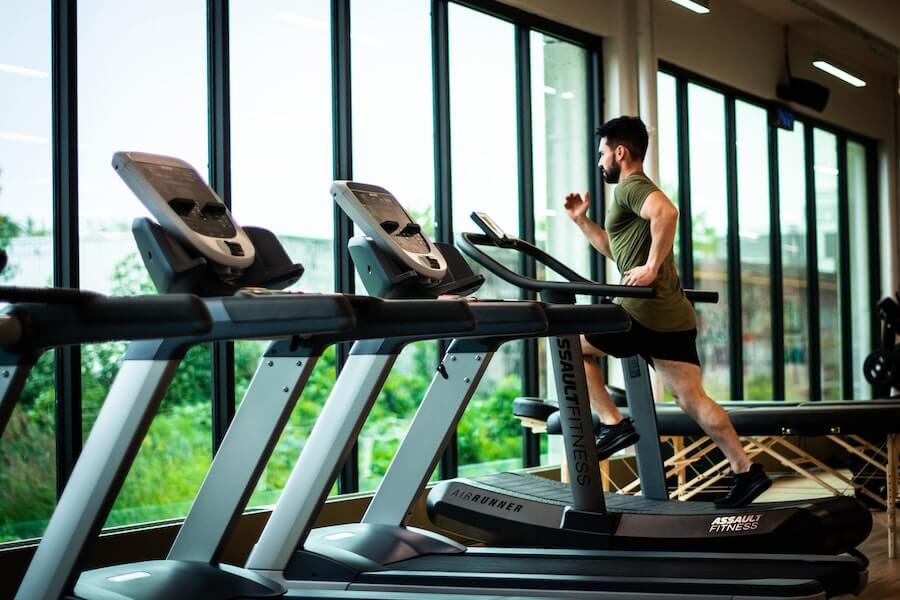Running is one of the most popular forms of exercise that can help you improve your cardiovascular health, reduce stress levels, and increase your energy and strength.
Most people run on concrete, especially in urban areas. However, concrete is a hard surface, so that it can be tough on the body.

This article will discuss whether running on concrete is as bad as some think and provide tips on reducing the potential risks.
Is it Safe to Run on Concrete?
As mentioned, most people run on concrete, especially in urban areas. So, yes, it’s safe to run on concrete. But it would help if you kept some things in mind before doing so.
Since concrete is a hard surface, running on it can put more stress on your joints than running on some softer surface like grass or dirt, so remember that.
However, concrete is a stable and consistent surface for your feet and can reduce the risk of ankle sprains and other unwanted injuries, so that’s a plus.
Some factors that play a role and can increase your safety while running on concrete include running technique and your footwear.
Proper running techniques, like landing with a midfoot strike rather than heel striking, can help reduce the impact on your joints.
Additionally, you can invest in good quality running shoes with cushioning to help absorb some of the shocks from running on concrete.
In short, running on concrete can be safe if you take precautions like investing in the proper footwear, being mindful of your running technique, and listening to your body to avoid injuries.
Is Running on Concrete Bad for Your Joints?
Running on concrete can impact your joints more than running on softer surfaces like grass, dirt trails, and synthetic tracks.
So, experts suggest avoiding concrete when possible.
That means concrete provides minimal shock absorption while running, which is bad for your joints, including your knees, hips, and ankles.
Over time this can contribute to various issues, such as joint pain and discomfort, and boost the risk of injuries like stress fractures and shin splints.
Using proper running techniques and wearing good-quality running shoes is essential to reduce the impact on your joints while running on concrete.
You can gradually increase your mileage and incorporate strength training exercises into your routine. This will help you avoid overuse injuries, strengthen the muscles around your joints and reduce the risk of injury.
You can run safely on concrete if you care for your body and use a proper running technique.

Is Running on Concrete Bad for Your Back?
Running on concrete can be bad for your back, especially if you already have back issues or your running technique or posture is compromised.
While the lower extremities primarily absorb the impact forces from running on concrete, the resulting shock and vibrations can transfer through the body, including the spine.
Therefore, here are a few factors you should consider related to the impact of running on concrete on your back:
1. Running Form and Posture
Poor running form, like slouching or overstriding, can increase the stress on your back while running on concrete. Therefore, you must maintain proper posture and use a good running technique to minimize the strain on your back.
2. Core Strength
If you have a strong core, which includes the abdomen, back, and hip muscles, it will help stabilize your spine and absorb some of the stress while running on concrete. You can strengthen your core muscles through specific exercises that will support your back.
3. Shock Absorption
Concrete is a hard surface and is less absorbent than other softer surfaces. Therefore, the repetitive impact forces generated while running on concrete can potentially transfer to your spine and add strain to the discs and joints in your back.
4. Individual Factors
We all have unique bodies, and the impact of running on concrete is different for each person. Some factors like pre-existing back conditions, running experience, overall fitness level, and biomechanics can influence how running on concrete will affect your back.
You should wear proper running shoes to reduce the potential impact on your back while running on concrete. Also, don’t suddenly increase your running mileage, speed, or intensity. Gradually progress your training and allow your body to adapt.
Moreover, maintain proper posture and efficient running technique to avoid excessive bouncing or overstriding.
Additionally, incorporate exercises that will help you strengthen your core muscles into your training routine. A strong core can help stabilize your spine and minimize the stress on your back.
Finally, listen to your body. Pay attention to any signs of pain, discomfort, or stiffness in your back while or after running on concrete.
If these symptoms persist or worsen, consult your healthcare professional for evaluation and help.
Is Running on Concrete Bad for Your Knees?
Running on concrete can impact your knees more than running on softer surfaces like track or grass. Over time this repetitive impact can cause discomfort, pain, and even knee injuries.
The impact on your knees while running on concrete can vary depending on your running form, footwear, joint health, and frequency and intensity of your running.
You can reduce the risk of knee injuries while running on concrete if you use the proper footwear, gradually increase your running routine, maintain proper running form, and strengthen your leg muscles.
Consider using other alternating, softer running surfaces like grass, dirt trails, or rubber tracks to reduce the overall impact on your knees.
If you notice any discomfort or pain, consult a healthcare professional to avoid unwanted knee injuries.
Is it Worse to Run on Concrete or Treadmill?

Running on concrete or a treadmill also has pros and cons; the best choice depends on your preferences.
Running on concrete is more challenging than running on the treadmill because it’s a hard surface and can cause more impact on your body. This can cause joint pain and injuries if you don’t use the proper running technique and wear good-quality running shoes.
Running on a treadmill provides a softer surface that can reduce the impact on your joints. It also allows you to control the speed and incline of your workout, which is suitable for interval training or targeting specific muscles.
However, running on a treadmill can be boring and monotonous, and you won’t get the fresh air and outdoor scenery as when running on concrete.
Running on a treadmill may be a better option if you have a history of joint pain or injuries. But if you prefer the fresh air and natural surroundings running on concrete is the better option.
Is Running on Concrete Bad: Conclusion
Running on concrete can be a challenging experience, especially for runners who have never run on hard surfaces. However, you can minimize the potential risks with proper preparation and technique and enjoy running.
Listen to your body, wear the proper footwear, and gradually increase your mileage to avoid injury.
If you stick to this, you can continue to enjoy the various physical and mental health benefits of running and minimize the impact on your joints and muscles.

I was working as a mountain guide, probably all around the planet. One day, I met my wife in the mountains, literally on top of the world. Now, I have a beautiful family and three kids, so I don’t have much time for climbing, but sometimes I go camping with my friends. I am also into gym workouts, and I can’t imagine my life without sports.
Since I ended my professional career as a climbing guide, I’ve been giving personal classes and helping amateurs to get ready for conquering their first peaks. Also, that’s how the whole blog idea appeared.





